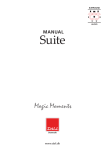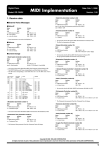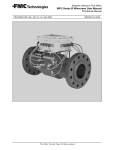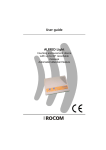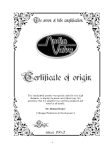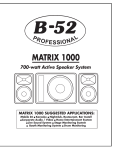Download Dali MENTOR SUB Operating instructions
Transcript
MANUAL
www.dali.dk
2
English
udiophile
oudspeaker
ndustries
DALI is renowned among music lovers throughout the world for its
unique speakers and cables, all constructed and build for uncompromising design and sound requirements. Our ultra-modern factory
in Denmark is fully equipped with facilities for development and
production of quality speakers.
Dali's principal competence is development and optimisation of
known and new technology in the field of audio and acoustics.
The result is continuous development and optimisation of new and
existing models.
We always keep our goal firmly in view for each and every DALI
speaker: To recreate sound experiences in your home that will carry
you away, making you forget time and place...
It is important to us that your new DALI speakers are set up and connected optimally. This manual contains our recommendations for
setup, connection and maintenance.
Enjoy!
DALI A/S
3
English
Safety
y
CAUTION
RISK OF ELECTRIC SHOCK
DO NOT OPEN
CAUTION:
TO REDUCE THE RISK OF ELRCTRIC SHOCK, DO NOT REMOVE THE BACK PANEL. NO USER-SERVICEABLE PARTS INSIDE. REFER SERVICING TO QUALIFIED PERSONNEL.
The lightning flash within an equilateral
triangle is intended to alert you to the presence of uninsulated „dangerous voltage“
within the product’s enclosure that may
be of sufficient magnitude to constitute an
electric shock to persons.
The exclamation point within an equilateral triangle is intended to alert you to
the presence of important operating and
maintenance (servicing) instructions in the
literature accompanying the appliance.
1. Read Instructions - All the safety and operating instructions should be read before the appliance is operated.
2. Retain Instructions - The safety and operating instructions should be retained for future reference.
3. Heed Warnings - All warnings on the appliance and in the operating instructions should be adhered to.
4. Follow Instructions - All operating and use instructions should be followed.
5. Water and Moisture - The appliance should not be used near water - for example, near a bathtub, washbowl, kitchen sink,
laundry tub, in a wet basement, or near a swimming pool and the like. Do not place anything containing liquids on the appliance.
6. Carts and Stands - The appliance should be used only with a cart or stand if recommended by the manufacturer.
7. Wall or Ceiling Mounting - The appliance should be mounted to a wall or ceiling only as recommended by the manufacturer.
8. Ventilation - The appliance should be situated so that its location or position does not interfere with proper ventilation. For
example, the appliance should not be situated on a bed, sofa, rug, or similar surface that may block the ventilation openings;
or placed in a built-in installation, such as a bookcase or cabinet, that mayimpede the flow of air through the ventilation
openings. Do not close or block any ventilation holes. Maintain free space between ventilation holes and wall.
9. Heat - The appliance should be situated away from heat sources such as radiators, heat registers, stoves, or other
appliances that produce heat. Do not place candles or other open flame on the appliance.
10. Power Sources - The appliance should be connected to a power supply only of the type described in the operating instructions
or as marked on the appliance.
11. Power Cord Protection - Power-supply cords should be routed so that they are not likely to be walked on or pinched by
items placed on or against them, paying particular attention to cords at plugs, convenience receptacles and the point
where they exit from appliance.
12. Cleaning - Do not use any liquid cleaners. Use only a dry cloth to wipe off dust and grease.
13. Non-use Periods - The power cord of the appliance should be unplugged from the outlet when left unused for a long
period of time.
14. Object and Liguid Entry - Care should be taken so that objects do not fall and liquids are not spilled into the enclosure
through openings.
15. Damage Requiring Service - The appliance should be serviced by qualified personnel when:
a. The power-supply cord or the plug has been damaged; or
b. Objects have fallen, or liquid has been spilled into the appliance; or
c. The appliance has been exposed to rain; or
d. The appliance does not appear to operate normally, or exhibits a marked change in performance; or
e. The appliance has been dropped, or the enclosure damaged.
16. Servicing - The user should not attempt to service the appliance beyond that described in the operating instructions.
All other servicing should be referred to qualified service personnel.
Maintain free space between ventilation holes and wall.
4
English
Manual
Congratulations on the purchase of your new DALI Concept speakers. In
this manual, you can read about set-up, adjustment and maintenance of
the Concept series speakers.
Standard accessories
Floor-standing DALI Concept speakers comes with 4 spikes for fitting
beneath the speaker. It is extremely important that these spikes are fitted
correctly to ensure speaker stability. Remember to tighten the lock nut
well once you have adjusted the height of the four spikes.
Bookshelf and center speakers are supplied with self-adhesive rubber feet
to ensure a stable and vibration-free set-up.
Maintenance
Clean the cabinets with a soft, dry cloth. If the cabinets are dirty, wipe with
a soft cloth dipped in all-purpose cleaner and then well wrung out. Be
very careful when wiping the speaker membranes, as they are very fragile.
Fabric frameworks can be vacuumed and wiped with a well-wrung, lintfree cloth and mild all-purpose cleaner
Free news letter from DALI
Sign up for the free e-mail news letter at www.dali.dk
Use the enclosed spikes or rubber feet for a stable set-up.
5
English
Running-in
g
Like any other mechanical system, a speaker needs to be "run in", so you
can look forward to a gradual improvement in sound quality over the initial period. Unlike other mechanical systems, a DALI speaker does not wear
out - in fact, regular use will extend its lifetime.
Connection
The connection to your amplifier is extremely important for your sound
experience.
Always turn off your amplifier before connecting any cables or altering
any connections.
Always use cables of the same type and length for left and right speakers. We recommend using special speaker cables from DALI, available from
your dealer.
For the perfect sound experience, the right speaker must be connected to
the output terminal marked "R" or "Right" on your amplifier and the left
speaker to the terminal marked "L" or "Left".
A detail that is often overlooked is connection in the correct phase, i.e. the
red terminal (+) on the amplifier should be connected to the red terminal
(+) on the speaker, and the black terminal
(-) on the amplifier should be connected
to the black terminal (-) on the speaker.
(Fig. 1) If just one speaker in a stereo or
surround sound system is not connected in
phase, the bass will be weak and the overall sound will be diffuse.
Fig. 1. Stereo connection
Always switch off your amplifier before adjusting any of the cables!
6
English
The same guidelines apply irrespective of the number of speakers in your
sound system: speakers positioned to the right must be connected to the
amplifier output terminal marked "R" or "Right", and any to the left must
be connected to "L" or "Left".
You must ensure that the cable ends are
firmly pushed into the terminals, and
that there are no loose wires, which
could cause a short circuit and damage
the amplifier. (Fig. 2)
Fig. 2. Terminal connection
Positioning
g
Once you have connected your new DALI Concept speakers, you need to
begin the process of searching for the perfect location for the speakers in
relation to your listening position - and adjusting the surround amplifier,
if applicable. It is worth spending a little time experimenting, as the correct set-up and tuning will provide a significantly better sound experience.
Here are some useful pieces of advice:
Avoid placing objects between the speakers and your listening position, as
obstructions can cause incorrect tonal balance.
Try to ensure that the distance between the left and right speakers is equal
to the distance from your listening position to the speakers (Fig. 3). If you
have surround sound, the distance between all the speakers should be symmetrically identical.
Fig. 3. Stereo positioning
DALI recommends DALI White Wave cables for Concept series
7
English
DALI Concept speakers has been designed using the Linear Directivity principle, which means that the tonal balance will be perfect, even if your listening position is not quite central. It is not recommendable to angle the
front speakers towards your listening position, unless the front speakers
are very far apart.
Surround
The Concept Center center channel loudspeaker is specially designed for
placement close to the large surface of a TV screen and can be placed
above or below the screen, to suit your needs. For both of these positions,
we recommend that the speaker’s front edge be on a line with the TV
screen. Attachment of the enclosed rubber feet is recommended to ensure
stable, non-resonant operation.
All DALI Concept models may be used as rear-channel loudspeakers. If
you wish to wall-mount your rear speakers, DALI Concept 1 is an excellent
choice, as it is factory-fitted with mounting hardware.
For the ultimate surround experience, a central listening position
is recommended, but, naturally,
you can also enjoy fine surround,
when not seated exactly in the
ideal “sweet spot” (Fig. 4).
Fig. 4. Surround setup
Even small changes in the listening room can affect the sound.
8
English
The DALI Concept series is also well-suited to a 7.1-channel surround setup, as shown in Fig. 5.
Fig. 5. 7.1 - channel surround setup
Wall-Mounting
g Concept 1
Concept 1 is particularly suited to wall-mounting, a useful feature, for instance,
when employed as rear loudspeakers in a surround system. Before wall-mounting, it is important to attach the enclosed rubber feet to the rear panel of the
loudspeaker as shown below. The rubber feet ensure stable contact with the
wall and create space for the loudspeaker cable.
Remember to attach the rubber feet when wall mounting Concept 1
9
English
Connecting
g Concept
p SUB
When you complement your stereo or surround sound system with the
Suite series subwoofer, Concept SUB, with active crossover network and
amplifier, you have two different connection options: connection to a surround amplifier subwoofer output terminal, or to a stereo amplifier line
output terminal.
Connection to surround amplifier with
separate subwoofer output terminal (Fig. 6)
If you want to use Concept SUB for reproduction of the special subwoofer
signal from a surround amplifier with separate subwoofer output terminal, connect this to the LFE input terminal on Concept SUB.
If the LFE input terminal is selected, the crossover network in Concept SUB
is not active. The LFE input terminal should therefore only be used together
with a special subwoofer output terminal in which the signal has already
been filtered, so the subwoofer only receives the lowest frequencies.
Fig. 6
DALI Concept speakers are well suited for 5.1 or 7.1 surround systems.
10
English
Connection to a stereo pre-amplifier (Fig. 7)
If you want to use Concept SUB to supplement the bass reproduction of
a stereo system, connect the subwoofer "Line in, Left/Right" to a stereo
signal on the pre-amplifier with full frequency content. The built-in crossover network in Concept SUB then ensures that the subwoofer only reproduces the lowest frequencies (see section on adjustments on page 11).
Fig. 7
In most cases you will achieve excellent results with one Concept SUB. It is
possible as a no-compromise stereo solution, or for reproduction of very
powerful sound pressure in a surround set-up in large rooms, to use two
Concept SUB. This solution is connected in the same way, but for stereo
you should only connect the left-hand channel to one input terminal on
the left-hand Concept SUB and the right-hand channel to one input terminal on the right-hand Concept SUB. For a surround set-up, parallel the LFEinputs of the two Concept SUB. In all other respects, follow the instructions
above - but use separate channels. You may wish to consult your dealer.
Note: When using two Concept SUB, the best results are normally achieved by positioning the two subwoofers relatively close to each other (1 - 2
metres).
If in doubt: Ask your DALI dealer for advice.
11
English
Tuning
g of Concept
p SUB
Once you have chosen the set-up and connection you are going to use, and
have positioned the subwoofer in the desired spot, you can begin the task
of tuning the system. Please note that the actual location of the subwoofer
greatly affects its contribution to the total acoustic image. For example,
if you put Concept SUB in a corner, the bass will be considerably stronger
than if it had been placed midway between two corners.
You can use the procedure below to achieve excellent results. Use a piece
of music you know well, preferably containing rhythmic bass tones such as
bass drum, electric bass or similar.
Begin by setting "Volume" and "Crossover" to the middle position ("12
o’clock"). Place the "Phase" switch in the 180° position, and set both
"Auto" and "Power" to the "ON" position.
7
3
8
4
9
1
6
11
1.
Mains lead
10
2.
Power, on/off switch
3.
On/off indicator
4.
Auto Stand-by
5.
Fuse
6.
Volume, volume control
7.
Phase, 0˚ og 180˚ phase switch
8.
Crossover frequency
9.
Heat sink, DO NOT COVER!
10.
LFE input
11.
Stereo Line level, Line signal
5 2
Setting level
Adjust the volume on your Concept SUB so the bass sound matches the level
from the front speakers. Adjust it so that you can hear the sound contribution
Placing Concept SUB in a corner will increase the bass level considerably.
12
English
from Concept SUB - but without the bass being too dominant. The bass should
be firm and precise, so that the subwoofer provides the bass that is present in
the music/sound track - neither more nor less. When connecting to a surround
sound system it may be an advantage to select a fixed setting for Concept SUB
and only adjust the level via the surround amplifier’s separate adjustment of
the subwoofer output level. If you over-modulate the subwoofer, your total
sound experience may be disturbed by distortion. Remember that the location
of Concept SUB has a major effect on the sound pressure you experience.
Choice of crossover frequency (with connection via "Line In, Left/Right")
Once the volume level is set you can tackle the equally important adjustment
of the crossover between the front speakers and Concept SUB. You do this
by adjusting "Crossover" up and down until you can hear the bass is smooth
and without "holes". You may need to readjust the volume slightly for this
adjustment.
Phase setting
Use the trial-and-error method for both settings - and you may also want to
try readjusting volume and crossover frequency. In all cases it is a good idea
to listen to the system for a couple of days and then readjust as required. The
same setting will not always be ideal for both surround and 2-channel stereo.
It is therefore always useful to make a note of your preferred settings for each
application.
The "Auto" function sets Concept SUB to stand-by mode after approximately
15 minutes with no signal to the input terminal. When Concept SUB receives a
signal again, the system will switch on automatically.
The "Power" button is the main switch for the system. It is best to switch the
system off completely when it is not going to be in use for long periods. When
making or changing connections, always shut the system down completely.
Overloading
If Concept SUB is intensely overloaded, the built-in safety circuit may completely disconnect the subwoofer. If this happens, turn down the volume
and turn off SUB for a moment before turning it on again.
Take your time adjusting Concept SUB - it is well worth the effort.
13
English
The listening
g room
Every room has its own distinctive acoustics, which influence the way we
experience the sound from a speaker. In actual fact, it's a matter of how
the room accommodates the sound and then dampens it. You can influence the acoustics of your listening room in various ways.
Some of the sound you hear comes not from the actual speakers but from
reflections from floor, ceiling and walls. These reflections are dampened
by objects such as furniture, plants and carpets. If the sound is bright, soft
items such as curtains and carpets can help. If the room has large window
panes, drawing the curtains will prevent reflections from the glass surfaces.
Both the amount and quality of the deep bass depend on the size and
shape of the room, and the position of the speakers. If positioned near
a side or back wall, this will accentuate the bass. A corner location will
accentuate it even more, but will also increase the reflections. The decision
is yours, so experiment with different positions to find which provides the
ideal sound for you.
As a basic rule, try to avoid large, hard and reflective areas in the immediate vicinity of your loudspeakers. In the same way that a mirror reflects
light, they will reflect sound from the speakers in almost full strength but
with a slight delay due to the relatively low speed of sound. This will disturb the precision and spacial effect of sound reproduction. Try hanging a
soft textile surface behind the speaker, place a rug in front of it, or place
a large plant to the side and experience the surprisingly large effect doing
so will have on the quality and precision of the sound.
Once you are happy with the positioning of your speakers, it is important
to ensure that they are completely stable. For floor models it is essential
that you use the accompanying spikes.
You can influence the acoustics of your listening room in many ways.
14
English
Power and acoustic pressure
How loud a speaker is able to play and still sound good is completely
dependent on the signal it has to reproduce. So, in practice, you cannot
define an unequivocal level for use in comparing different speakers.
Obviously, lots of pure, undistorted output
from a large amplifier is better than a distorted
signal from a small amplifier stretched beyond
its capacity. The signal from a distorting (clipping) amplifier contains much more highfrequency information than an undistorted
signal, and therefore puts a heavy strain on
the tweeter. Consequently, speakers are most
often damaged by small amplifiers having to
work too hard - and very rarely by large amplifiers, which are practically running idle.
It is worth noting that when the tone controls
are turned above the neutral setting this significantly burdens both speakers and amplifier.
On a good sound system tone controls should
only be used to compensate for poor recordings and not to permanently compensate for
weaknesses elsewhere in the system. So, DALI
recommends that the tone controls generally
be set to the neutral position, and you achieve
your desired sound image through correct
positioning of the speakers.
Ensuring that you keep the volume low enough so the sound remains clear
and undistorted will minimise the strain on both speakers and amplifier.
DALI recommends that the tone controls are set to neutral position.
15
English
DALI - more than meets the eye
Your DALI speakers have been designed on the basis of a long succession
of technical solutions based on many years' intensive development work.
Most of this is not seen - but it can be heard and experienced, including:
An even frequency response ensures that your DALI speakers reproduce
all tones and kinds of music faithfully and without emphasis.
Sound distribution and correct timing are among DALI's specialities, as
all DALI speakers are designed for optimum performance in a real home
environment and not just in a specially-constructed listening room. The
perfect timing in the sound reproduction ensures that a light beat on a
snare drum, for example, is reproduced as the light, sharp tap that it really
is - without the drums filling and muddying the sound image.
Low loss in movable parts means that the speakers can reproduce very
fine details, even at low sound levels.
Internal cables and crossover networks are an important but frequentlyoverlooked point. The internal cables and crossover networks in your DALI
speakers are - like every component - high quality.
The loudspeaker units in your DALI speakers have been developed based
on our ultimate sound requirements. This ensures that the most delicate
details, such as a harp string or a puff of air, will be reproduced just as
convincingly as the powerful sound of a car door slamming etc.
At DALI the cabinet is both a piece of furniture and the speaker's sound
base, and is therefore constructed from acoustically-correct materials.
As with all the other components, the cabinets undergo a rigorous final
inspection, guaranteeing that only perfect speakers are labeled with the
DALI name.
Enjoy your new DALI speakers!
16
English
Specifi
p
cations
There are countless methods measuring speakers. However, none of them
actually represent how a speaker really sounds. Only by listening it is possible to determine whether one speaker sounds better than another. So
we only give you the specifications that are of real value to you. The DALI
Concept range has been designed to reproduce music as honestly as possible - and we know we have succeeded. Enjoy your new speakers!
Concept 1
Concept 2
Concept 6
Concept 8
Concept 10
Concept Center
Frequency Response [Hz]
62.5-22500
43-25000
41-25000
41-25000
35-25000
72-22500
Crossover Frequency [Hz]
3000
3000
3000
610 / 3500
600 / 3200
2500
Sensitivity (2,83V/1m.) [dB]
87
87
91
90
91
91
Nominal Impedance [Ohm]
8
8
8
6
6
8
106
108
110
112
114
109
25-100
40-120
30-150
40-160
50-200
25-120
1 x 1"
1 x 1"
1 x 1"
1 x 1"
1 x 1"
1 x 1"
-
-
-
1 x 5"
1 x 6½"
-
1 x 5"
1 x 6½"
2 x 6½"
2 x 8"
2 x 10"
2 x 5"
Maximum SPL [dB]
Recommended Amp. Power (8 Ohm) [Watt]
High Frequency Driver
Midrange Driver
Low Frequency Driver
Bass Reflex System Resonanse [Hz]
Dimensions (H x W x D) [cm]
Dimensions (H x W x D) [inch]
Weight [kg]/[lb.]
58.5
42.5
38.0
36.5
29.5
55.0
31x17x19
39x20x26
93x20x26
103x25x36
113x30x42
16x50x23
12.2x6.7x7.5 15.4x7.9x10.2 36.5x7.9x10.1 40.5x9.8x14.0 44.4x11.8x16.3
6.3x19.7x8.9
4 / 8.8
6.3 / 13.9
14.2 / 31
25 / 55
34 / 75
Concept SUB
Design Principle
Active, built-in amplifier and crossover, sealed enclosure
Low Frequency Driver
1 x 12" air-dried pulp cone
Amplifier
160 Watt RMS
Stereo line signal input RCA, input impedance 20 k
Inputs
LFE Line signal input RCA, input impedance 35 k
Controls
Volume level, lowpass crossover 50 - 170 Hz, phase ( 0 or 180˚)
Frequency Response
29-170 Hz
Maximum SPL
110 dB
Power Consumption
115/230 VAC, 50 - 60 Hz, 330 Watt
Dimensions (H x W x D) [cm]
41x38x42
Dimensions (H x W x D) [inch]
16.2x15.0x16.6
Weight [kg]/[lb.]
21.2/46.7
Wave
DALI cables for DALI speakers.
6.6 / 14.5
















